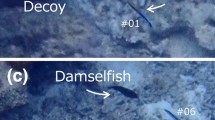Summary.
Detection of heterospecific predators and prey via chemical cues is well known, but only a few studies have examined the potential for such discrimination in cannibalistic systems. In newts, Notophthalmus viridescens, adults are opportunistic predators of conspecific larvae. I used a laboratory bioassay to determine whether larvae and adults distinguish between chemical stimuli from members of the different age classes. Larvae distinguished between chemical stimuli from larvae and adults by decreasing their activity only following exposure to stimuli from adults. Decreased activity is consistent with an antipredator response in many prey species, including larval newts. In contrast, adults increased their activity and increased time spent in open areas in response to stimuli from larvae, but not to stimuli from adults. Increased activity is consistent with a feeding response; adults also showed increased activity and increased time in open areas in response to chemical stimuli from familiar heterospecific prey (brine shrimp). The proximate cue that allowed the newts to distinguish between the different age classes is not associated with short-term dietary differences because all stimulus animals were fed the same prey. Stimulus “strength” was controlled by diluting the stimulus solutions according to the volume of the stimulus animal. Therefore, there appear to be intrinsic differences in the chemical signatures of larval and adult newts.
Similar content being viewed by others
Author information
Authors and Affiliations
Corresponding author
Rights and permissions
About this article
Cite this article
Mathis, A. Use of chemical cues in detection of conspecific predators and prey by newts, Notophthalmus viridescens . Chemoecology 13, 193–197 (2003). https://doi.org/10.1007/s00049-003-0248-y
Accepted:
Issue Date:
DOI: https://doi.org/10.1007/s00049-003-0248-y




